Batteries are crucial for any device that relies on portable power – from vehicles to isolated energy systems and anything in between. An often-used method is linking 12V batteries in parallel to bolster power capacity while ensuring consistent voltage. The primary goal of this blog post is to guide readers through a comprehensive step-by-step tutorial on how to effectively set up 12 Volt Batteries in Parallel arrangement.
Understanding 12v Parallel Battery Connections
Parallel battery configurations link two or more 12v Parallel to amplify overall power capacity while preserving a constant 12V output. This setup connects all the positive terminals and all the negative terminals. The primary benefit of this configuration is that each additional battery will contribute to the total current capacity. The result?
A lengthier duration of power supply. It’s like adding more fuel tanks to a vehicle—while the speed (voltage) remains the same, the distance you can travel (current capacity or amp hours) increases. By understanding the principles of parallel battery connections, you can harness more power for your devices without needing higher voltage.
When to Use a Parallel Connection
Parallel battery configurations prove beneficial when you desire an enhanced Ampere-hour (Ah) capacity but wish to keep the voltage constant. Essentially, this connection increases the longevity of your power supply without altering the voltage level. It’s a common choice for a wide range of applications requiring an extended power supply but without high voltage.
This could range from recreational vehicles and boats, which often require reliable and long-lasting energy sources, to solar energy and backup power systems that are built to provide a steady power supply over a longer duration. Therefore, consider a parallel connection when you want to expand your power supply’s life while retaining the voltage at a steady 12V.
The Required Tools and Components
A handful of critical instruments and components are necessary to establish a parallel battery system. Firstly, depending on the desired power capacity, you will need two or more 12V batteries. Secondly, for connections, you should have battery cables of the same length to ensure equal resistance and power distribution.
High-quality battery terminal clamps are also required to fasten the cables to the battery terminals securely. A wrench, a wire cutter, and a mustimeter are needed for assembly and troubleshooting. The wrench and wire cutter will assist in physically setting up the connections, while the mustimeter will be critical in testing and ensuring that the parallel setup is functioning correctly. All these tools and components will ease the installation process and ensure a robust and efficient parallel battery system.
The Step-by-Step Installation Process
To start:
- Make sure all devices connected to the batteries are turned off.
- Please attach one of your cables from the positive terminal of the first battery to the positive terminal of the second.
- Repeat this step with another cable, connecting the first battery’s negative terminal to the second battery’s negative terminal.
- Ensure that these connections are secure and tightened properly; a loose connection could lead to inefficiencies in your system. You can use your wrench to tighten any connections that may seem loose or insecure.
This completes the basic setup of your parallel battery system. However, it’s important to note that safety precautions should always be taken while installing, such as using gloves and safety glasses to protect against possible battery acid exposure..
 Safety Measures during Installation
Safety Measures during Installation
While embarking on the installation process, it’s paramount to prioritize safety. Commence by donning protective gear, including safety glasses and gloves. This not only safeguards your eyes but also your hands from potential battery acid exposure. Be vigilant about your surroundings, and keep in mind that batteries emit flammable gases.
Hence, keeping the installation area free from sparks and flames and preventing smoking near the workspace is critical. A crucial procedure to remember is the order of connection. Always initiate by connecting the positive terminals, followed by the negative ones. Adhering to these safety guidelines will ensure a secure and risk-free battery installation process.
Checking and Maintaining Your 2 12v Batteries in Parallel Setup
Maintaining the functionality of your 2 12v Batteries in Parallel setup involves consistent checks. Make it a habit to inspect your battery terminals for signs of corrosion regularly. If you spot any, clean them promptly. Utilize a mustimeter to gauge the total voltage of your setup; it should consistently read at 12V.
Monitoring the electrolyte levels of batteries that aren’t maintenance-free is vital. They should be checked frequently; if they appear low, replenish them with distilled water as needed. This routine maintenance will ensure your parallel battery setup operates efficiently and reliably.
Understanding the Advantages and Limitations
Installing 12V batteries in parallel increases power capacity, allowing for prolonged usage of your devices. This comes without the necessity for an increase in voltage, catering to the requirements of various appliances and systems demanding consistent voltage levels. However, this setup has its challenges. Imbalances in charging and discharging may arise if the batteries are of different make, age, or capacity. The same issue can occur if the lengths of the cables used for connection differ, leading to inconsistent resistance and power distribution.
Despite these potential hiccups, with regular upkeep and setup monitoring, these limitations can be kept at bay. Careful selection of batteries and cable length at the setup stage can also prevent these issues, promoting a smooth and efficient operation of your parallel battery setup.
Additionally, a balanced charging system can ensure equal power distribution among the batteries. This optimal configuration contributes to your parallel battery system’s overall performance and longevity.
Testing and Troubleshooting Your Setup
To ensure your parallel battery setup is functioning correctly, use your mustimeter. Begin by measuring the voltage of each battery. Following this, measure the total voltage across the parallel configuration. The readings should align with your expected 12V output. If there are discrepancies in the readings, it’s time to investigate your connections and the state of your batteries.
Any loose or corroded connections should be addressed, and batteries showing signs of wear or damage may need to be replaced. In the event of continuous issues or if you cannot identify the problem, it may be necessary to seek the assistance of a professional. Regular testing and troubleshooting are key to maintaining an efficient and reliable parallel battery setup.
Consider a routine maintenance schedule, as this could extend the lifespan of your batteries and keep your system running optimally. Preventative maintenance could involve cleaning battery terminals, checking the electrolyte levels and applying terminal protectors.
Optimizing Your 2 12 Volt Batteries in Parallel Performance
Achieving optimal performance from your parallel battery configuration entails some strategic measures. It’s crucial to use identical batteries, not just in type but also in age and capacity. This uniformity reduces the likelihood of imbalances in charging and discharging, contributing to a more efficient system. Another factor to consider is temperature. Batteries can be sensitive to extreme temperatures, both hot and cold.
Thus, it’s important to house your 2 12 Volt Batteries in Parallel in an environment with controlled, moderate temperatures. This prevents premature battery wear and ensures consistent power output. Following these guidelines can enhance your parallel battery system’s performance and give it a longer lifespan.
In addition, regular maintenance checks will also allow you to spot any irregularities before they become bigger issues, ensuring your system remains reliable and efficient. Always remember that proper care, combined with correct installation, will significantly extend the life of your 12V parallel battery setup.
Common Mistakes to Avoid During Parallel Battery Installation
The installation of a parallel battery system has potential pitfalls. One common mistake involves mixing different types, ages, or capacities of batteries within the same parallel setup. This lack of uniformity can trigger imbalances in the charging and discharging processes. Likewise, paying attention to the cables’ length when connecting the batteries can result in uneven resistance and unequal power distribution across the setup. Always opt for cables of identical length to maintain equal distribution of power.
Furthermore, lose or insecure connections can lead to inefficiencies and possible system failures. Remember to tighten all connections securely and routinely inspect your setup to avoid any possible connection-related issues. Avoiding these common mistakes will ensure the efficient operation of your parallel battery system and prolong the lifespan of your batteries.
In the following section, we will dive into a step-by-step guide for the installation process. Understanding each step will empower you to install your 12V batteries in parallel confidently and correctly.
FAQs
Q: Can I use different types of 12V batteries in parallel?
A: While possible, it’s not recommended as it can result in charging and discharging imbalances. Always use identical batteries for the best performance.
Q: What if my mustimeter doesn’t read 12V for my parallel setup?
A: If you’re not getting a 12V reading, check your connections and batteries for any issues. If you need help to identify the problem, consider consulting a professional.
Q: Why should I use cables of the same length for connections?
A: Identical cable lengths ensure equal resistance and power distribution. Different lengths could result in uneven power distribution, affecting your setup’s efficiency.
Q: How often should I check my batteries and connections?
A: Regular inspections are key. Look for signs of corrosion and ensure connections are secure. For non-maintenance-free batteries, also keep an eye on the electrolyte levels.
Q: What happens if I connect the batteries in the wrong order?
A: Connecting in the wrong order could damage your batteries or cause a short circuit. Always connect positive terminals first, followed by the negative terminals.
Conclusion
Linking 12V batteries in parallel is an effective way to enhance the power capacity of your system while maintaining a constant voltage level. This strategy especially benefits applications requiring prolonged power supply without high voltage. The installation process involves some careful steps and safety precautions, but it is simple. Equipped with the right tools and components, you can successfully set up a robust parallel battery system by adhering to the safety measures. It is essential to be mindful of the potential challenges and common mistakes during installation and maintenance, ensuring regular checks and proper care to keep the setup running efficiently. By understanding and applying these principles, you can maximize the performance and lifespan of your batteries, thereby optimizing your power supply system. So, whether you’re powering your recreational vehicle for a long road trip or setting up a backup power system for your home, installing 12V batteries in parallel can be a game-changer. Embrace this powerful strategy to harness and control your energy source effectively.
This Article Was First On Published
| Other Good Articles to Read |
| Blogs Rain |
| Cme Blog Spot |
| Garcias Blogs |
| Yyc Blogs |
| Guiade Blogs |
| Blogs-Hunt |
| Impact-Blog |
| Smarty Blogs |
| Ed Blog |
| Mo Blogs |
| Blogs Em |
| Blogs T |

